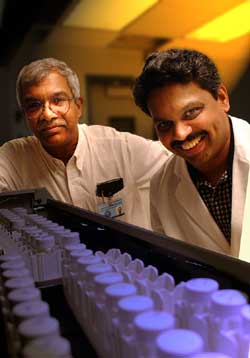New study pursues the impact of pregnancy on drug efficacy

Drs. Vadivel Ganapathy (left) and Puttur D. Prasad are part of National Institutes of Health Program Project grant looking at whether pregnant women should continue to take many common medications at the same dose as before pregnancy. <br>
Whether pregnant women with conditions ranging from ulcers to AIDS should keep taking the same doses of medicine they took before pregnancy is a question Medical College of Georgia researchers want answered.
They are betting they’ll find that to maintain efficacy, pregnant women will need higher doses and that the placenta, a 2-pound temporary organ of pregnancy, is why.
“The idea that we are developing is that pregnant women are so different from non-pregnant women in terms of drug handling,” said Dr. Vadivel Ganapathy, biochemist and interim chairman of the MCG Department of Biochemistry and Molecular Biology. “In non-pregnant women, only the intestine, liver and kidney are important to drug handling.”
But the placenta – where mother and fetus connect and the fetus’ source of nutrients and oxygen – also can metabolize many drugs so they no longer function as drugs or it can transport drugs directly to the fetus.
“Normally the placenta is believed to be a barrier, a protective mechanism for the baby, so if the mother’s blood contains some drugs, the placenta is believed not to let it go the fetus. But that is not true for all drugs,” said Dr. Ganapathy, who has studied the placenta’s interactions with everything from street drugs to folic acid.
He has cloned a transport system expressed in high levels in the placenta – called an organic cation transporter, or OCT3, because it can handle a broad spectrum of therapeutic drugs that contain a positive charge. “We are still trying to figure out the physiological role of this transporter, but we know it transports a lot of drugs,” he said.
Now, as part of a National Institutes of Health Program Project grant at the University of Washington at Seattle, he is using the drug-handling capacity of this transporter to study the impact of pregnancy on drug efficacy. He’ll be looking at how the transporter impacts drugs levels in animal models as well as human placental cells in culture.
“We ought to know more about the placenta, what it does in terms of drugs, before we give the same dosage, the same regimen to pregnant women that we give to non-pregnant women,” Dr. Ganapathy said.
As an example, the common anti-ulcer medication, cimetidine, known by the trade name Tagamet, readily interacts with the cation transporter. He’s using that drug to learn how much the drug level in the blood is affected by pregnancy. “A lower blood level may be innocuous with cimetidine, but what if you are treating a patient who has AIDS with anti-viral drugs?” Dr. Ganapathy said. “In a non-pregnant state, this particular anti-viral drug at a given dose is very good at keeping the level of HIV low in the blood. Now, if that HIV patient is pregnant and you give the same drug at the same dosage, that might not be enough to keep the viral load low. The viral load increases in the mother’s blood which also increases the chance of passing it through the placenta and on to the baby.”
Animal studies examining a drug’s impact on a developing fetus are routinely done as part of drug development and Dr. Ganapathy will be doing that as part of his study, too. These fetal studies sometimes show that medications can’t be taken during pregnancy at any dose.
But studies on the impact on drug efficacy for the mothers-to-be have not been pursued, Dr. Ganapathy said, and dosages typically are not altered for those women.
This issue is central to the five-year study at MCG and the University of Washington, which was recently established as one of 11 new Specialized Centers of Research on Sex and Gender Factors by the NIH.
“We will look at the organic cation transporter, or OCT3, which is expressed primarily in the placenta and handles a lot of drugs, as a way to characterize the drugs normally used in pregnant women which can be handled by this transporter,” Dr. Ganapathy said of his $1.5 million grant. “These drugs should be flagged saying the efficacy of the drug may be altered during pregnancy because you have this transporter sitting there during pregnancy which can transport these drugs, take it away from the mother and put it into the baby.” Dr. Puttur D. Prasad, researcher in the MCG Department of Obstetrics and Gynecology, is a co-investigator on Dr. Ganapathy’s study.
Related studies at the University of Washington will use non-therapeutic doses of common, non-toxic drugs to see if blood levels vary in pregnant versus non-pregnant women and primates.
Media Contact
More Information:
http://www.mcg.edu/All latest news from the category: Health and Medicine
This subject area encompasses research and studies in the field of human medicine.
Among the wide-ranging list of topics covered here are anesthesiology, anatomy, surgery, human genetics, hygiene and environmental medicine, internal medicine, neurology, pharmacology, physiology, urology and dental medicine.
Newest articles

First-of-its-kind study uses remote sensing to monitor plastic debris in rivers and lakes
Remote sensing creates a cost-effective solution to monitoring plastic pollution. A first-of-its-kind study from researchers at the University of Minnesota Twin Cities shows how remote sensing can help monitor and…

Laser-based artificial neuron mimics nerve cell functions at lightning speed
With a processing speed a billion times faster than nature, chip-based laser neuron could help advance AI tasks such as pattern recognition and sequence prediction. Researchers have developed a laser-based…

Optimising the processing of plastic waste
Just one look in the yellow bin reveals a colourful jumble of different types of plastic. However, the purer and more uniform plastic waste is, the easier it is to…



